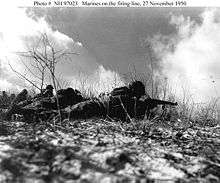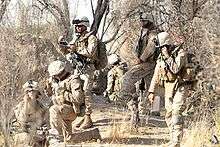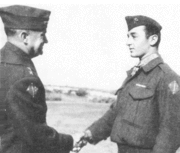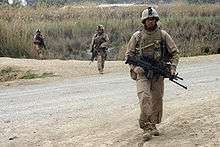2nd Battalion 7th Marines
| 2nd Battalion, 7th Marines | |
|---|---|
|
2nd Battalion, 7th Marines insignia | |
| Active |
|
| Country | United States |
| Allegiance | United States of America |
| Branch | United States Marine Corps |
| Type | Light Infantry |
| Size | 1,200 |
| Part of |
7th Marine Regiment 1st Marine Division |
| Garrison/HQ | Marine Corps Air Ground Combat Center Twentynine Palms |
| Nickname(s) | "War Dogs" |
| Motto(s) | "Ready for anything, counting on nothing." |
| Anniversaries | 1 January 1940 |
| Engagements |
World War II *Guadalcanal Campaign *Battle of Cape Gloucester *Battle of Peleliu *Battle of Okinawa Korean War *Battle of Inchon *Battle of Seoul *Battle of Chosin Reservoir *East Central Front *Western Front *Defense of the DMZ Vietnam War Operation Desert Storm Operation Iraqi Freedom *Operation Vigilant Resolve *Operation Alljah Operation Enduring Freedom |
| Commanders | |
| Current commander | LtCol Christopher Steele |
The 2nd Battalion, 7th Marines (2/7) is a light infantry battalion of the United States Marine Corps. They are based at the Marine Corps Air Ground Combat Center Twentynine Palms and consist of approximately 800 Marines and Sailors. The battalion falls under the command of the 7th Marine Regiment and the 1st Marine Division.
Subordinate units
- Headquarters & Service Company
- Echo Company
- Fox Company
- Golf Company
- Weapons Company
At the beginning of World War II, the battalion had three subordinate rifle companies – E (Easy), F (Fox), G (George) – a weapons company designated as H (How), and a Headquarters Company. As the war progressed, the weapons company was eliminated and the component elements redistributed throughout the headquarters and rifle companies.[1][2] During the Korean War the battalion's three rifle companies were designated D (Dog), E (Easy) and F (Fox).[3] During the Vietnam War the battalion was organized under a four rifle company order of battle – E (Echo), F (Fox), G (Golf) and H (Hotel).[4]
History
World War II
Guadalcanal
The battalion was activated on 1 January 1940 at Guantanamo Bay, Cuba. On 18 September 1942, 2/7 landed on Guadalcanal. They fought the Battle of Guadalcanal for four months until they were relieved by elements of the United States Army's Americal Division. The battalion was then sent to Australia along with the rest of the 1st Marine Division for rest and refit.
Operation Cartwheel
2/7 landed on Cape Gloucester, New Britain on 26 December 1943 securing an airfield the first day. That night, Japanese Marines counterattacked and 2/7 took the brunt of the assault and the fighting continued throughout the night. By the time the sun began to rise, the entire Japanese force had been wiped out. On 14 January, 2/7 along with the rest of the regiment assaulted and took the last Japanese stronghold on the island, Hill 660. Two days later, the counter-attack came but the Marines held the hilltop often resorting to hand-to-hand fighting.
The battalion continued to run patrols around the island to protect against guerrilla attacks from hold-out Japanese soldiers. In March 1943, New Britain were declared secure and on 1 April Marine Division was relieved by the US Army 40th Infantry Division. 2/7, and the rest of the 1st Marine Division again returned to Australia.
Battle of Peleliu
On 15 September 1944, the 7th Marines (minus the 2nd battalion) landed along with the rest of the 1st Marine Division. Note: The 2nd battalion was the only battalion to be held in reserve. They were to go in later in the day in support of the 7th Marines. However, Chesty Puller's 1st Marines were having the worst time as they were on the left flank and adjacent to where the mountainous area on Peleliu called the Umurbrogal Pocket began - where all the Japanese holed up. On the night of 20 September the 2nd battalion went out to the transfer line, but there were not enough LVT's. Instead, they had to wait and go in the next morning directly in support of Chesty Puller's 1st Marines. The 2nd battalion went right into the middle of the fighting of the 1st marine regiment. When they landed they were met by intense artillery and mortar fire from Japanese positions that had not been touched by the pre-invasion bombardment. On 20 September, the 7th Marines broke out of their beachhead and linked up with the 1st Marines. The battalion fought on the island for another eight weeks before it was secured.
Battle of Okinawa
On 1 April 1945, was part of the 80,000 Marines that landed on Okinawa. The 1st Marine Division landed on the southern portion of Okinawa against light resistance. Their beachhead was quickly secured and supplies began flowing in. Resistance began to become stronger as the Marines pushed north. The 1st Marine Division was ordered into Reserve to protect the right flank of the invasion forces. The battalion fought the Japanese along the coast and was stopped suddenly at the Shuri Castle. For 30 days, along with the rest of the Division and the Army 77th Infantry Division, battled the Japanese stronghold.
After Okinawa, 2/7 was part of the occupation in China where they were to disarm the Japanese forces there. In addition they were called upon to keep the peace during the bloody civil war between the Chinese Nationalists and Communist forces. In 1947, 2/7 returned to California and were deactivated later that year.
Korean War

During the Battle of Chosin Reservoir Captain William Barber earned the Medal of Honor for his actions as commander of Fox 2/7. F/2/7 held a position known as "Fox Hill" against vastly superior numbers of Chinese infantry, holding the Toktong Pass open and keeping the 5th Marine Regiment and the 7th Marine Regiment from getting cut off at Yudam-ni. His company's actions to keep the pass open, allowed these two regiments to withdrawal from Yudam-ni and consolidate with the rest of the 1st Marine Division at Hagaru-ri. The mission to relieve F/2/7 on top of Fox Hill also led to LtCol Raymond Davis, then commanding officer of 1st Battalion 7th Marines, receiving the Medal of Honor.[5] In addition to Chosin, the Battalion participated in the Inchon Landing, the recapture of Seoul and operations along both the Eastern and Western Fronts.

Vietnam War
2/7 was deployed to Vietnam from July 1965 until October 1970 as part of the 7th Marine Regiment, 1st Marine Division. The Battalion operated in the southern half of I Corp most of the time. Qui Nhon, Chu Lai, Da Nang Air Base, Dai Loc and An Hoa.
The Gulf War and the 1990s
2/7 relocated during January 1990 to Marine Corps Air Ground Combat Center Twentynine Palms, California, and participated in Operations Desert Shield and Desert Storm in Saudi Arabia and Kuwait from August 1990 through March 1991 when they redeployed back to the United States. For the rest of the 1990s the battalion took part in the regular Unit Deployment Program (UDP) rotation to Okinawa. In this scheme, 7th Marine Regiment sequentially rotated one of its battalions to Camp Schwab for six months to serve as one of the three battalions attached to the 4th Marine Regiment. In October 1994, 2nd Battalion 7th Marines boarded the USS Belleau Wood (LHA-3) and USS San Bernardino (LST-1189) to sail from Okinawa to the Philippines to take part in the 50th Anniversary reenactment of the landings at Leyte Gulf.
Iraq
During the 2003 invasion of Iraq, 2/7 was stop-moved in Okinawa until the Summer of 2003. The battalion deployed in February 2004 in support of Operation Iraqi Freedom (OIF). They were among the first Marines redeployed to the country after the initial invasion, and lost eight Marines during that deployment. The battalion deployed in support of OIF for the second time from July 2005 to January 2006. They operated in the Al-Anbar Province and suffered 13 Marines killed in action. The battalion was again deployed to Al-Anbar from January to August 2007. During this third Iraq deployment, 2/7 suffered 8 Marines killed in action.
Afghanistan

2/7 deployed to Helmand and Farah Provinces, Afghanistan from April to December 2008. The battalion spearheaded the return of Marines to Afghanistan, and was engaged in heavy combat with insurgent elements throughout their deployment.[6] 2/7 operated from Camp Bastion and bases in Sangin, Gereshk, Musa Qaleh, Now Zad, Delaram, Gulistan, Bakwa and Bala Baluk. Called "the hardest hit battalion in the Corps this year," The battalion suffered 20 men killed and 160 wounded, thirty of which were amputees.[7] 2/7 returned to Afghanistan in 2012.
Okinawa, Unit Deployment Program, and the 31st MEU
Following its Afghanistan deployment, 2/7 deployed to Okinawa for the first time since 2003. The Battalion was the ground combat element for the 31st Marine Expeditionary Unit from December 2009 - June 2010, and then again from June–December 2011.
Unit awards
A unit citation or commendation is an award bestowed upon an organization for the action cited. Members of the unit who participated in said actions are allowed to wear on their uniforms the appropriate ribbon of the awarded unit citation. 2nd Battalion, 7th Marines have been awarded the following:
| Streamer | Award | Year(s) | Additional Info |
|---|---|---|---|
| Presidential Unit Citation Streamer with one Silver and four Bronze Stars | 1942, 1944, 1945, 1950, 1950, 1951, 1965–1966, 1966–1967, 1967–1968, 1968 | Solomon Islands, Peleliu – Ngesebus, Okinawa, Korea (Inchon Landing, Chosin Reservoir, Punchbowl), Vietnam War | |
| Navy Unit Commendation Streamer with one Silver and one Bronze Star | 1952–1953, 1965, 1968, 1990–1991, 2002–2003, 2007, 2008 | Korea, Vietnam, Southwest Asia, Western Pacific, Iraq, Afghanistan | |
| Meritorious Unit Commendation Streamer with one Bronze Star | 1968, 1968 | Vietnam War | |
| American Defense Service Streamer with one Bronze Star | 1941 | Cuba | |
| Asiatic-Pacific Campaign Streamer with one Silver Star | 1943, 1944, 1945 | Guadalcanal, Eastern New Guinea, New Britain, Peleliu, Okinawa | |
| World War II Victory Streamer | 1942–1945 | Pacific War | |
| Navy Occupation Service Streamer with "ASIA" | 2–26 September 1945 | Okinawa | |
| China Service Streamer | 30 September 1945 – 5 January 1947 | North China | |
| National Defense Service Streamer with three Bronze Stars | 1950–1954, 1961–1974, 1990–1995, 2001–present | Korean War, Vietnam War, Gulf War, War on Terrorism | |
| Korean Service Streamer with one Silver and four Bronze Stars | September 1950 – March 1955 | Inchon-Seoul, Chosin Reservoir, East Central Front, Western Front, Defense of the Demilitarized Zone | |
| Vietnam Service Streamer with two Silver and three Bronze Stars | July 1965 – October 1970 | Qui Nhon, Chu Lai, Da Nang, Dai Loc, An Hoa | |
| Southwest Asia Service Streamer with two Bronze Stars | 1990–1991 | Desert Shield, Desert Storm | |
| Afghanistan Campaign Streamer with two Bronze Stars | 2008, 2012 | Helmand and Farah Provinces (Consolidation II, Transition I) | |
| Iraq Campaign Streamer with three Bronze Stars | July 2005 – January 2006, February – August 2007 | Al Anbar Province (Iraqi Governance, National Resolution, Iraqi Surge) | |
| Global War on Terrorism Expeditionary Streamer | March – October 2004 | Al Anbar Province (Transition of Iraq) | |
| Global War on Terrorism Service Streamer | 2001–present | ||
| Korea Presidential Unit Citation Streamer | 21–27 September 1950, 26 October 1950 – 27 July 1953 | Korea | |
| Vietnam Gallantry Cross with Palm Streamer | 7 July 1965 – 20 September 1969 | Vietnam | |
| Vietnam Meritorious Unit Citation Civil Actions Streamer | 21 September 1969 – 12 October 1970 | Vietnam | |
Medal of Honor

Ten Marines and one Sailor have been awarded the Medal of Honor while serving with 2d Battalion, 7th Marines.
- Sgt Mitchell Paige – 26 October 1942
- PFC Charles H. Roan – 18 September 1944 (posthumously)
- PFC John D. New – 25 September 1944 (posthumously)
- Cpl Lee H. Phillips – 4 November 1950 (posthumously)
- SSgt Robert S. Kennemore – 27–28 November 1950
- PFC Hector A. Cafferata Jr. – 28 November 1950
- Capt William E. Barber – 28 November-2 December 1950
- Sgt Daniel P. Matthews – 28 March 1950 (posthumously)
- Hospitalman Richard De Wert – 5 April 1951 (posthumously)
- SSgt Ambrosio Guillen – 25 July 1953 (posthumously)
- PFC Oscar P. Austin – 23 February 1969 (posthumously)
Other notable former personnel
- Ralph Abell, awarded the Navy Cross after taking over for Capt Barber as CO of F/2/7.
- Brian Blonder – Navy Cross awarded for actions while attached to 2/7 in Afghanistan during 2008.
- James Brady - served with 2/7 during the Korean War, including platoon commander and executive officer with D Company and battalion intelligence officer.
- Ronald D. Castille – served with 2/7 during the Vietnam War.
- John Chafee – served with 2/7 during the Korean War.
- Brady Gustafson – Navy Cross, Afghanistan 2008.
- Herman H. Hanneken, Medal of Honor, Battalion Commander on Guadalcanal.
- Chee Kwan - Top Shot (Season 4) contestant, served with 2/7 in Iraq during 2007 and Afghanistan during 2008.
- Angel Mendez – Navy Cross, Vietnam War.
- Anthony Swofford – served with 2/7 during the Gulf War.
- Roy Tackett – served with 2/7 during World War II.
- Paul K. Van Riper, Battalion Commander 1983–1985.
- Richard Weinmaster – Navy Cross, Afghanistan 2008.
In popular culture
- One of the subplots in Season 1 Episode 10 of the television series The West Wing, In Excelsis Deo, centers around Toby Ziegler getting involved in the fate of a dead homeless person who Zeigler identifies to the police as a former Marine and Korean War veteran by a 2/7 tattoo on the dead man's arm.
- 2/7 is highlighted in a 2008 deployment to Afghanistan in the book '15 Years of War' where the Marines fought one of the most arduous battles the Marine Corps has seen in Now Zad, Afghanistan.
See also
| Wikimedia Commons has media related to 2nd Battalion 7th Marines. |
- Al Anbar campaign
- List of United States Marine Corps battalions
- Organization of the United States Marine Corps
Notes
- ↑ The United States Marine Infantry Battalion
- ↑ "Operations of the 2nd Battalion, 7th Marines, 1st Marine Division at the Malimbu River and the Metapona River on Guadalcanal Island, 1 November 1942 to 8 November 1942" by Maj C. J. Mabry USMC
- ↑ D Company, 2nd Battalion, 7th Marines, Korea
- ↑ Hotel 2/7 Vietnam
- ↑ Russ Breakout, pp. 176–183, 219–225, 257, 293–293.
- ↑ Henderson, Kristin (21 June 2009). "A Change in Mission". The Washington Post.
- ↑
References
 This article incorporates public domain material from websites or documents of the United States Marine Corps.
This article incorporates public domain material from websites or documents of the United States Marine Corps.
- Bibliography
- Brady, James (2005). The Scariest Place in the World – A Marine Returns to North Korea. New York City: Thomas Dunne Books. ISBN 0-312-33243-2.
- Drury, Bob; Clavin, Tom (2009). The Last Stand of Fox Company. New York City: Atlantic Monthly Press. ISBN 0-87113-993-6.
- Russ, Martin (1999). Breakout – The Chosin Reservoir Campaign, Korea 1950. Penguin Books. ISBN 0-14-029259-4.
- Web
- "2/7's official website". Twentynine Palms, United States Marine Corps. Archived from the original on 22 February 2009.
- "2d Battalion 7th Marines". GlobalSecurity.org. Archived from the original on 14 March 2007. Retrieved 8 March 2007.
- "History of the 7th Marines". www.bakeroneseven.com. Archived from the original on 14 February 2005. Retrieved 11 December 2007.
- "2d Battalion, 7th Marines at marzone.com". www.marzone.com. Archived from the original on 9 March 2009. Retrieved 15 March 2009.
- "2d Battalion, 7th Marines at MarineParents.com". www.marineparents.com. Retrieved 22 August 2009.



